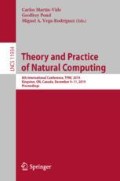Abstract
The landscape of isolated areas has been changed due to human intervention to support vehicular transport, however, this is a hectic job, therefore, if our vehicles are morphed to mimic nature, the landscape would not need to be changed. Robots and vehicles inspired from nature are very hard to control because of multiple number of actuators. Manual methods (such as programming individual actuators to form a walking pattern) fall short because of the complexity. Therefore, an automated process that employs artificial intelligence (AI) to evolve locomotion gaits for quadrupedal robots is needed. AI has been used before as well; however, most of the AI implementations are only done in simulation without hardware execution. This article attempts to use genetic algorithms to evolve locomotion gaits that are later implemented on robots both via simulations and real implementation. The simulation is run for 200 generations and the best result is put into effect on a hardware robot. Our results show that the gait is successfully transferred; however, the results are not perfect and suffer from the reality gap. These results also help us conclude that gaits designed for a specific environment have a better chance of transferring than gaits that have been designed without taking into account the surface the robot walks on.
Access this chapter
Tax calculation will be finalised at checkout
Purchases are for personal use only
References
Pfeifer, R., Bongard, J.C.: How the Body Shapes the Way We Think: A New View of Intelligence. MIT Press (2006)
Bongard, J.C.: Evolutionary robotics, evolutionary robotics. Commun. ACM 56, 74–83 (2013)
Pongas, D., Mistry, M., Schaal, S.: A robust quadruped walking gait for traversing rough terrain. In: Proceedings - IEEE International Conference on Robotics and Automation, pp. 1474–1479. IEEE, Roma (2007). https://doi.org/10.1109/ROBOT.2007.363192
Hauert, S., Zufferey, J.C., Floreano, D.: Reverse-engineering of artificially evolved controllers for swarms of robots. In: 2009 Congress on Evolutionary Computation CEC 2009, pp. 55–61 (2009). https://doi.org/10.1109/CEC.2009.4982930
Juang, C.F., Yeh, Y.T.: Multiobjective evolution of biped robot gaits using advanced continuous ant-colony optimized recurrent neural networks. IEEE Trans. Cybern. 1–13 (2017). https://doi.org/10.1109/TCYB.2017.2718037
Masood, J., Samad, A., Abbas, Z., Khan, L.: Evolution of locomotion controllers for snake robots. In: 2016 2nd International Conference on Robotics and Artificial Intelligence, ICRAI 2016, pp. 164–169 (2016). https://doi.org/10.1109/ICRAI.2016.7791247
Reil, T., Husbands, P.: Evolution of central pattern generators for bipedal walking in a real-time physics environment. IEEE Trans. Evol. Comput. 6, 159–168 (2002). https://doi.org/10.1109/4235.996015
Yosinski, J., Clune, J., Hidalgo, D., Nguyen, S., Zagal, J.C., Lipson, H.: Evolving robot gaits in hardware: the HyperNEAT generative encoding vs. parameter optimization. In: Proceedings of European Conference on Artificial Life, pp. 1–8 (2011)
Nygaard, T.F., Torresen, J., Glette, K.: Multi-objective evolution of fast and stable gaits on a physical quadruped robotic platform. In: 2016 IEEE Symposium Series on Computational Intelligence, SSCI 2016 (2017). https://doi.org/10.1109/SSCI.2016.7850167
Glette, K., Klaus, G., Zagal, J., Torresen, J.: Evolution of locomotion in a simulated quadruped robot and transferral to reality. In: Proceedings of the Seventeenth International Symposium on Artificial Life and Robotics, pp. 1–4 (2012)
Sofge, D.A., Potter, M.A., Bugajska, M.D., Schultz, A.C.: Challenges and opportunities of evolutionary robotics. Robotics (2003)
Juang, C.F., Chen, Y.H., Jhan, Y.H.: Wall-following control of a hexapod robot using a data-driven fuzzy controller learned through differential evolution. IEEE Trans. Ind. Electron. 62, 611–619 (2015). https://doi.org/10.1109/TIE.2014.2319213
Phillips, A., Du Plessis, M.: Towards the incorporation of proprioception in evolutionary robotics controllers. In: Proceedings - 3rd International Conference on Robotic Computing IRC 2019. 226–229 (2019). https://doi.org/10.1109/IRC.2019.00041
D’Ausilio, A.: Arduino: a low-cost multipurpose lab equipment. Behav. Res. Methods 44, 305–313 (2012). https://doi.org/10.3758/s13428-011-0163-z
Eckert, P., Ijspeert, A.J.: Benchmarking agility for multilegged terrestrial robots. IEEE Trans. Robot. 35, 529–535 (2019). https://doi.org/10.1109/TRO.2018.2888977
Author information
Authors and Affiliations
Corresponding author
Editor information
Editors and Affiliations
Rights and permissions
Copyright information
© 2019 Springer Nature Switzerland AG
About this paper
Cite this paper
Mir, U., Khan, Z., Mir, U.I., Naseer, F., Shah, W. (2019). Evolution of Locomotion Gaits for Quadrupedal Robots and Reality Gap Characterization. In: Martín-Vide, C., Pond, G., Vega-Rodríguez, M. (eds) Theory and Practice of Natural Computing. TPNC 2019. Lecture Notes in Computer Science(), vol 11934. Springer, Cham. https://doi.org/10.1007/978-3-030-34500-6_14
Download citation
DOI: https://doi.org/10.1007/978-3-030-34500-6_14
Published:
Publisher Name: Springer, Cham
Print ISBN: 978-3-030-34499-3
Online ISBN: 978-3-030-34500-6
eBook Packages: Computer ScienceComputer Science (R0)

